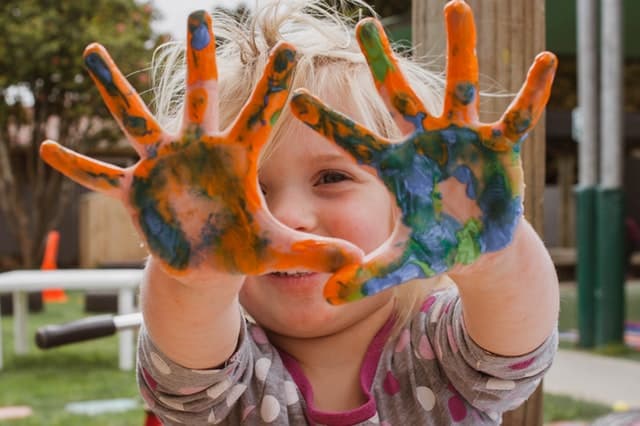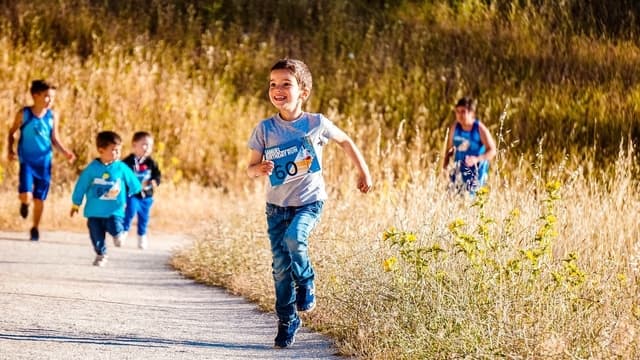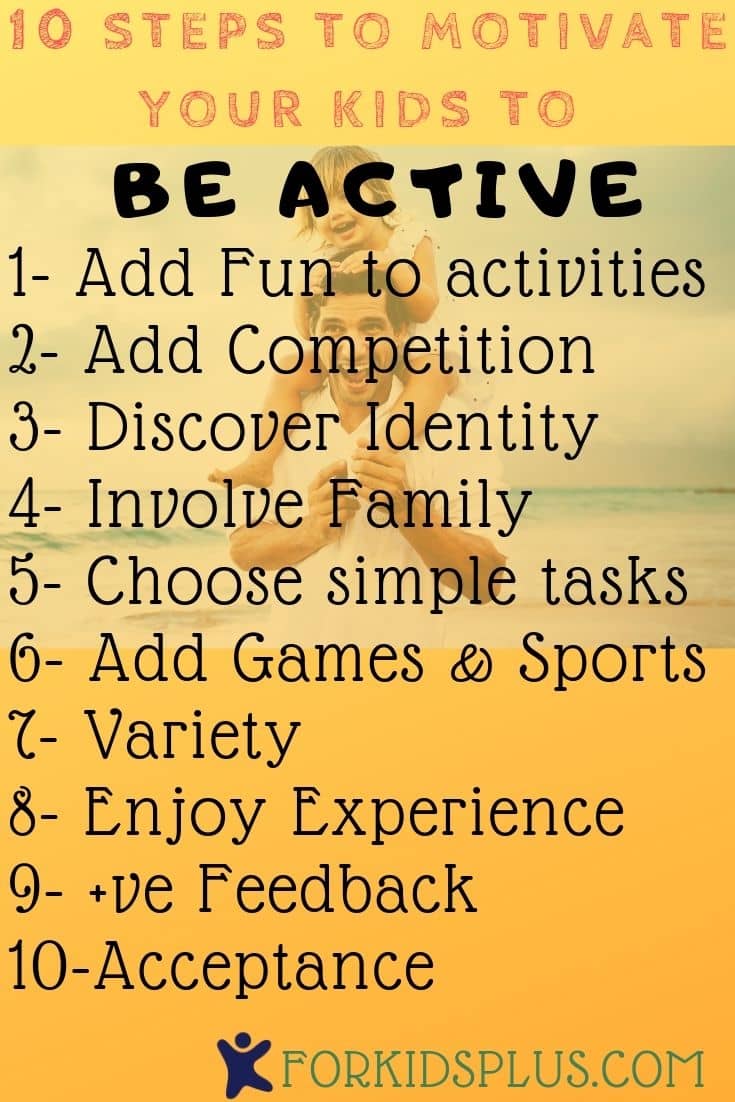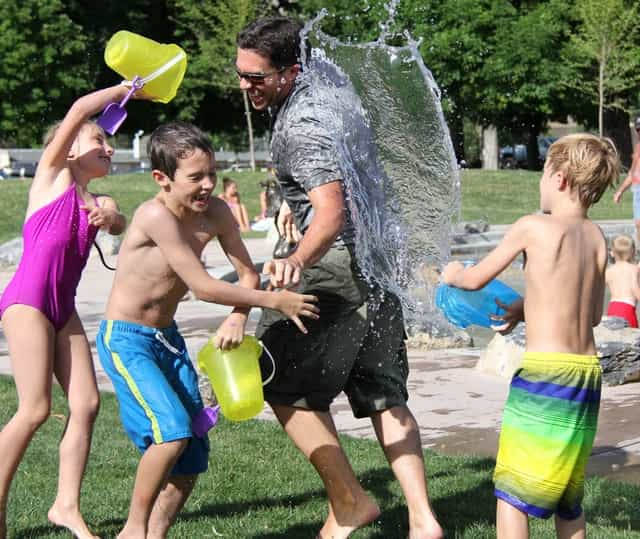The secret to becoming physically active—which lies within each one of us, young and old—is that we all have something that motivates us.
Whether that motivation is the way running makes us feel or the desire to be like our idol, tapping into it is like tapping into a superpower.
Motivation can give us an increased level of energy and make us run farther and jump higher.
That motivation, the source of superpower, can be either internal or external.
The secret to motivating the children in your life to exercise, then, is to find out where their superpower comes from and to use this power in every activity.
In this article, For Kids will go through 10 ways to motivate children and make them active.
10 things that motivate kids
Table of Contents
- 1. Fun
- 2. Competition
- 3. Socialized Activities
- 4. Friends and Family
- 5. Simple Tasks
- 6. Logical Thinking
- 7. Variety
- 8. Enjoyment
- 9. Positive Feedback
- 10. Validation
1. Make activities fun
Kids can be silly and are naturally playful. They take play very seriously.
Think of the word “play” as an attitude towards life, rather than as a form of action. Having a playful attitude towards any activity opens up a world of creative fun.
Play is also essential to children’s development because it contributes to their cognitive, physical, social and emotional well-being.
Engaging in play can be even more powerful for a child if friends and family members are involved in it.
Make time to play every day, even on those days when you think you don’t have any time for fun.
Exercise should be as fun as you can possibly make it, both for you and the children around you.
It should be an enjoyable experience, so the children keep coming back for more.
Go ahead and get creative—you can make anything fun! It can be as simple as asking the children, “How can we make this fun?”
2. Add the right amount of competition
Competitiveness is a learned behaviour. Between the ages of six and eight, kids will experience competition either at home or outside the home.
They may pick up competitive traits from their parents, their siblings, their teachers, their coaches or almost any social circumstance.
This is a good age to teach children how to keep competition in perspective. With a little direction, they’ll develop a healthy attitude towards being competitive and have fun with it.
There are various levels of competition, and most depend on the child’s age, temperament, culture, sex and skill level.
Put in perspective, competition encourages children to work harder (and as part of a team), helps them build confidence and teaches them good sportsmanship by impressing upon them the need to win and lose gracefully.
Children of any age should feel valued, regardless of the outcome of any activity.
Be careful with your criticism to ensure that it doesn’t appear that your approval and love for your children are dependent on whether they win or lose at a game or any other activity.
Focus on the process of playing, strategizing and having fun, instead of on the outcome of the activity.
3. Discover the kids’ identity

At this early age, kids begin to tell the world who they are. By doing so, they’re building a sense of identity and self-esteem.
This can be a fragile time in their self-discovery process, so it’s important to encourage kids to feel good about themselves.
Kids also enjoy being a part of a group, sport or club, or identifying themselves with a sports celebrity.
Specific to exercise, kids often like to dress the part—maybe by dressing like a cyclist or wearing the jersey of their favorite sports team.
Adult leaders can use these common traits of children to their advantage: The more kids think and feel like athletes, the more fun they’ll have and the more committed they’ll be to their sport or style of exercise.
4. Involve friends and family
As kids’ social skills develop, they tend to become more thoughtful and think more about others’ reactions.
Friends
Because of the developmental stages, childhood is the time when kids start to make friends (although most of their friends are of the same sex, at this point).
Indeed, children of this age group want a parent to be involved in their activities, but by the age of six, friends also begin to become prominent in kids’ lives.
So for this age group, involving friends, family, a coach, a personal trainer or a mentor when it comes to creating a healthy lifestyle can provide a significant amount of motivation for most kids.
No matter who you choose to partner with your child, you want to make sure that that person has the same, or even a greater sense of commitment towards the child’s healthy lifestyle as you do.
This is important because the habits that are developed in childhood often stay with people throughout their lives.
Exercise and active play need to be at the top of your priority list for your child, but it’s important to make them a fun habit and not a chore to be checked off a list.
Family members
In addition to parents, other family members and older friends automatically become role models for younger children, so we need to live by example.
The less you say, and the more you do, the more of an impact you’ll have on the children around you. Therefore, you should make physical activity part of your family or social group’s daily routine.
Try playing active games together, as this is a great way to combine quality time and an active lifestyle.
It’s a good idea to take your kids to places where everyone can be active, such as parks, community baseball diamonds, soccer fields or basketball courts.
Miniature golf and batting cages are a lot of fun for everyone, too. Take walks or go for a bike ride; do anything but sit (Note: It’s especially important to limit “screen” time!).
Children within this age group shouldn’t sit for longer than two hours at a time, unless they’re sleeping or in school. Even household chores are a physical activity, and they teach children responsibility.
From toddlers to teens, all children need to learn responsibility by contributing to daily chores and errands.
Family activities
Assigning chores tells a child they’re a contributor to the family or social group and that the family or group works as a team to get things done.
To encourage children to do chores, you’ll need to make the chores fun, so turn tasks into games when possible. Make a chart and give each child points for things like putting clothes away.
Add a small basketball hoop to the clothes hamper so children can make a basket when they throw in their dirty socks, or make a contest to see who can pick up the most LEGOs. Set a timer and record the results.
Always provide plenty of praise when a job is done, as you want kids to feel good about contributing to the family or group.
10 recommended chores for children aged six to eight:
- Carrying out the trash
- Folding clothes
- Putting away their own clothes
- Picking up toys
- Helping in the garden
- Helping wash the car
- Making their own bed
- Setting and/or clearing the table
- Taking care of pets (feeding them, helping walk them)
- Wiping the bathroom sink
5. Choose simple and easy tasks
A child’s mind will be growing rapidly throughout their childhood years, so this is a good time to teach them to follow instructions and rules and to practice good sportsmanship.
Follow this procedure with any exercise, game, or activity:
- Make sure you know beforehand how to perform or play the exercise, game or activity
- Communicate the rules so that they’re simple to follow
- Be prepared and have all the equipment you’ll need
6. Pick games that teach reasoning and
encourage thinking

School-aged children will typically begin to think and reason through situations.
Games and exercises can be used to develop and strengthen their reasoning skills.
Teaching our children new skills to jump-start their growth can help them develop physical and mental confidence.
Children need to develop competence in regard to their basic movement skills, because simpler movements are the building blocks for more complex movements.
To motivate children to be competent, give them praise for a job well done and give them encouragement at times when they feel they could’ve done better.
Allowing older children to teach younger children how to play a game and allowing children to use their imaginations within games and activities will also motivate them.
7. Have children learn something new as an adventure
Learning a new sport or activity will empower children to open their minds, meet new people, experience other cultures, challenge their muscles in different ways, and satisfy their desire to be unique.
You can learn a new sport or skill as a family or as part of a group of friends.
Try fly-fishing, rock climbing, backpacking or something simpler like a new Yoga move or a new swim stroke.
Try snorkeling; if you enjoy it, take a vacation during which your entire family can share in this type of adventure.
But before you set off on that snorkeling trip to Mexico, be sure the children going with you have the skills necessary to be able to snorkel. Consider their age, skill level and interests.
8. Encourage enjoyment of the experience
Since humans are emotional beings, we’re driven by how we feel about people, places and things.
What children really want are feelings of pleasure and satisfaction about the things that they do and accomplish.
All of us are motivated by experiences that make us feel good, while most of us will avoid those experiences that make us feel bad or frighten us.
As adults, we need to keep this in mind when introducing children to new activities.
If we see children experiencing fear when faced with a new game, skill or sport, for instance, we need to look at the situation and figure out why.
Perhaps the workout is too hard or too competitive. Is there a risk involved? Does the child think it may make them look foolish to their friends?
Whatever the fear might be, you must identify it. Once the fear is gone or overcome, then the children can focus on the fun of the activity.
9. Provide results and feedback
When working with children, you want to build pride, confidence and muscle all at the same time.
In the pursuit of healthy children, look past the pursuit of a healthy body; this must also involve the pursuit of a healthy mind. To raise a well-balanced child, you can’t have one without the other.
A positive message stimulates and empowers anyone, especially kids.
Words have power; they can build someone up or they can tear someone down.
As a result, especially when working with children, you’ll want to choose your words carefully and think about the value and delivery of your feedback.
Positive reinforcement can increase self-confidence, so giving children personal compliments is important.
You must also make sure you give specific feedback, as this increases the value of each statement.
10. Offer validation
Feelings of acceptance and validation must start at home.
Children have a strong need for love and understanding from their parents, as well as their peers. Kids want and need their parents’ attention and approval.
We all possess the desire to be someone who’s valued or do something that’s valuable.
Some children have the desire to be like others, while others strive to be unique.
One thing that’s common in children is that no child likes to be compared to another child in a negative way.
Find the strengths within each individual child and develop them, but don’t push a child into a sport or activity because you played it as a child or because a friend’s children are involved in it now.
If a child doesn’t want to play on an organized team, don’t push them in that direction.
Instead, explore the list of individual sports mentioned throughout this site with your children. Maybe skateboarding is more their style.
If a child wants to be different from others, let them try a sport that’s not common, such as fencing or kickboxing.


